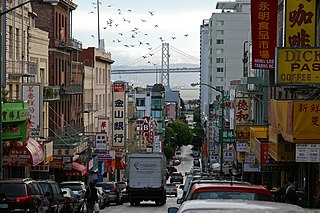
The Chinatown centered on Grant Avenue and Stockton Street in San Francisco, California, is the oldest Chinatown in North America and the largest Chinese enclave outside Asia. It is also the oldest and largest of the four notable Chinese enclaves within San Francisco. Since its establishment in 1848, it has been highly important and influential in the history and culture of ethnic Chinese immigrants in North America. Chinatown is an enclave that continues to retain its own customs, languages, places of worship, social clubs, and identity. There are two hospitals, several parks and squares, numerous churches, a post office, and other infrastructure. Recent immigrants, many of whom are elderly, opt to live in Chinatown because of the availability of affordable housing and their familiarity with the culture. San Francisco's Chinatown is also renowned as a major tourist attraction, drawing more visitors annually than the Golden Gate Bridge.

Chinatown is a neighborhood in Downtown Los Angeles, California that became a commercial center for Chinese and other Asian businesses in Central Los Angeles in 1938. The area includes restaurants, shops and art galleries but also has a residential neighborhood with a low-income, aging population of about 20,000 residents.

The San Francisco Public Library is the public library system of the city of San Francisco. The Main Library is located at Civic Center, at 100 Larkin Street. The library system has won several awards, such as Library Journal's Library of the Year award in 2018. The library is well-funded due to the city's dedicated Library Preservation Fund that was established by a 1994 ballot measure, which was subsequently renewed until 2022 by a ballot measure in 2007.

The Chinatown neighborhood in Oakland, California(Chinese: 屋崙華埠), is traditionally Chinese which reflects Oakland's diverse Chinese American, and more broadly Asian American community. It is frequently referred to as "Oakland Chinatown" in order to distinguish it from nearby San Francisco's Chinatown. It lies at an elevation of 39 feet.

Benjamin Fong-Torres is an American rock journalist, author, and broadcaster best known for his association with Rolling Stone magazine and the San Francisco Chronicle.
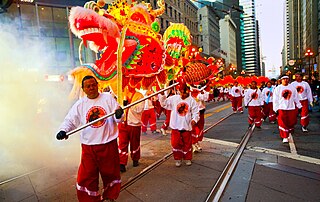
The San Francisco Chinese New Year Festival and Parade is an annual event in San Francisco. Held for approximately two weeks following the first day of the Chinese New Year, it combines elements of the Chinese Lantern Festival with a typical American parade. First held in 1851, along what are today Grant Avenue and Kearny Street, it is the oldest and largest event of its kind outside of Asia, and the largest Asian cultural event in North America. The parade route begins on Market Street and terminates in Chinatown.
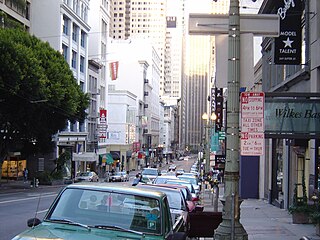
The Forbidden City was a Chinese nightclub and cabaret in San Francisco, which was in business from 1938 to 1970, and operated on the second floor of 363 Sutter Street, between Chinatown and Union Square.
Pam Chun is a writer and marketing consultant, most notable as the author of the book The Money Dragon.

Flower Drum Song is a 1961 American musical film directed by Henry Koster, adapted from the 1958 Broadway musical Flower Drum Song, written by the composer Richard Rodgers and the lyricist/librettist Oscar Hammerstein II, in turn based on the 1957 novel of the same name by the Chinese American author Chin Yang Lee. The film stars Nancy Kwan, James Shigeta, Miyoshi Umeki, Jack Soo, Benson Fong, and Juanita Hall. It was nominated for five Academy Awards and two Golden Globe Awards, including Best Motion Picture – Musical or Comedy.

Edsel Ford Fung was an American restaurant server from San Francisco, California. He was called the "world's rudest, worst, most insulting waiter" and worked at Sam Wo restaurant.
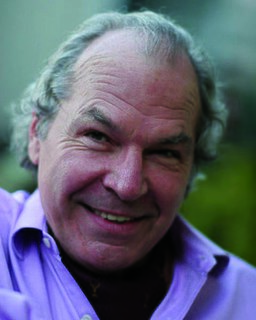
James Norwood Pratt is an American author, educator, and speaker, on the topics of wine, tea, and tea lore. Known as "America's Tea Sage," he is possibly the world's most widely read authority on tea and tea lore.

尤方玉屏, Alice Fong Yu was the first Chinese American public school teacher and a community organizer in San Francisco, California. She was a founding member and first president of the Square and Circle Club (方圓社), and was a prominent leader in the San Francisco Chinatown community.
The Joe Boys, or JBS, was a Chinese American youth gang founded in the 1960s in San Francisco's Chinatown. The Joe Boys were originally known as Joe Fong Boys, after its founder Joe Fong, a former member of the Wah Ching. Most of their members were born in Hong Kong or were of Hong Kongese descent.
This article contains a list of the Chinatowns, which are either officially designated neighborhoods or historically important, in the United States. Historically speaking, many of these Chinatowns were formed in the 1800s Chinese diaspora and have served as ethnic Chinese enclaves.
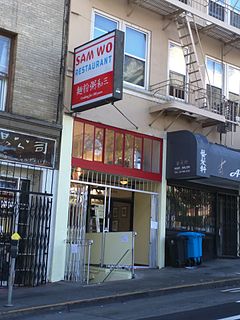
Sam Wo is a Chinese restaurant located in San Francisco, California. The restaurant's first location on 813 Washington Street was famous for being a venerable mainstay in the local Chinatown area, having been in the same location since 1907. Sam Wo gained notoriety in the 1980s for being the employer of Edsel Ford Fung, who was known locally as the "world's rudest waiter". The restaurant was closed in 2012 due to safety concerns, and reopened in 2015 on nearby Clay Street.
Hongkongese Americans, include Americans who are also Hong Kong permanent residents who identify themselves as Hongkongers, Americans of Hong Kong ancestry, and also Americans who have Hong Kong parents.
Johnny Kan (1906-1972) was a Chinese American restaurateur in Chinatown, San Francisco, ca 1950-1970. He was the owner of Johnny Kan's restaurant, which opened in 1953, and published a book on Cantonese cuisine, Eight Immortal Flavors, which was praised by Craig Claiborne and James Beard. Kan and Cecilia Chiang are credited with popularizing authentic Chinese cuisine as a fine dining option, displacing the stereotypical chop suey American Chinese cuisine prevalent in the 1950s and 60s.
As of 2012, 21.4% of the population in San Francisco was of Chinese descent, and at least 150,000 Chinese American residents. The Chinese are the largest Asian American subgroup in San Francisco. San Francisco has the highest percentage of residents of Chinese descent of any major U.S. city, and the second largest Chinese American population, after New York City. The San Francisco Area is 7.9% Chinese American, with many residents in Oakland and Santa Clara County. San Francisco's Chinese community has ancestry mainly from Guangdong province, China and Hong Kong, although there is a sizable population of ethnic Chinese with ancestry from other parts of mainland China and Taiwan as well.

Oriental Public School, founded as The Chinese School, was a public school located in Chinatown, San Francisco, California. It was initially set up in 1859 as a segregated school for schoolchildren of Chinese descent, part of the growing anti-Chinese sentiment in the United States that arose in the late 1800s. The school has been renamed a number of times, most recently in 1998 to the Gordon J. Lau Elementary School in honor of the city's first Chinese-American supervisor.

The Dragon Gate is a south-facing gate at the intersection of Bush Street and Grant Avenue, marking a southern entrance to San Francisco's Chinatown, in the U.S. state of California. Built in 1969 as a gift from the Republic of China (Taiwan) in the style of a traditional Chinese pailou, it became one of the most photographed locations in Chinatown, along with the older Sing Fat and Sing Chong buildings.













